QCF: Blaster Master Zero 1 & 2 Collector's Edition
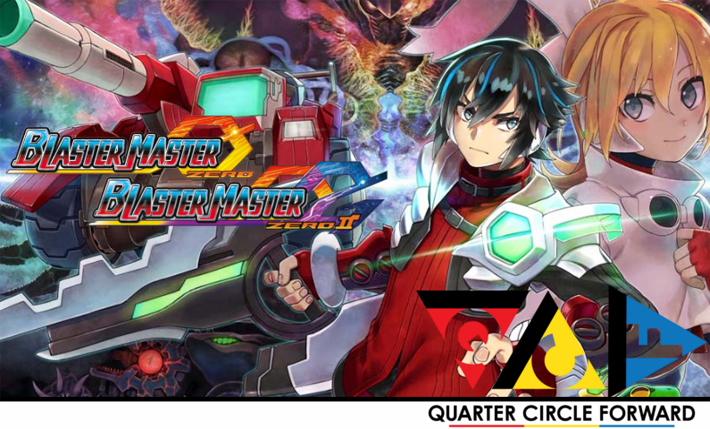
 ith Blaster Master Zero 3 currently available for preorder on Limited Run Games for both Switch and Playstation 4, and what appears to be the kind of quality we found in the Blaster Master 1 & 2 Collectors Edition being put into the trilogy's conclusion, you know we're going to be on it, 100%.
ith Blaster Master Zero 3 currently available for preorder on Limited Run Games for both Switch and Playstation 4, and what appears to be the kind of quality we found in the Blaster Master 1 & 2 Collectors Edition being put into the trilogy's conclusion, you know we're going to be on it, 100%.
And that's weird to say, since we hadn't played neither Blaster Master Zero 1 nor 2 through to completion. Unlike the NES Original, which was finally conquered in Bullet Heaven #302 after a period of over 25 years, Blaster Master Zero has always been more approachable generally speaking, so it was finally time to hunker down and marathon both, back to back.

Blaster Master Zero was first released to the Nintendo Switch on march 3rd, 2017 with subsequent releases to WinPC in June 2019, PS4 in June 2020 and, most recently, Xbox One and Series consoles on July 1, 2021.
It was both developed and published by Inti Creates as the second reboot of the Sunsoft Original after Blaster Master Overdrive in 2010. As such, it bears resemblance to the original in a lot of ways, while implementing many new features and mechanics as well as quality of life improvements and story exposition.
Let's Dive in.
We took an exhaustive look at the original Blaster Maser in episode 302 of Bullet Heaven, and a lot of the same mechanics found there are present in Blaster Master Zero as well.
Players take control of Jason Frudnik, who descends into a subterranean world to rescue a forg-like creature named Fred aboard the powerful Sophia III Tank. Like Blaster Master and many of its sequelsvand spinoffs before it, Blaster master Zero features two different perspectives with distinctly different kinds of action for each.
Aboard the Sophia, players will play the game as a sidescrolling action-platforming run-n-gunner with heavy Metroidvania DNA. Securing upgrades and parts to get to the next areas are pretty much as 'Vania as it gets, something that was prevalent in the original as well. Players will gradually obtain more and more abilities such as hovering and submarine motion, as well as several special weapons to take on the many mutant enemies Jason will encounter. Special abilities and weapons requires special energy to deploy, which can be recovered with blue energy capsules, or over time. Sophia's life can also be replenished by green capsules.
To get these parts, Jason will have to disembark from the Sophia to enter and clear out a number of run-n-gunning sections with an overhead perspective. Care should be taken though, as fall damage returns with death resulting in too high a fall. Water will break Jason's fall though, which is a very helpful feature.
In the overhead areas, players can move in any one of eight directions, armed with a blaster and a powerful grenade attack. Thanks to the expanded capabilities of modern gamepads compared to the NES Controller, a number of additional controls are also available, chief of them being a dedicated Strafe button.
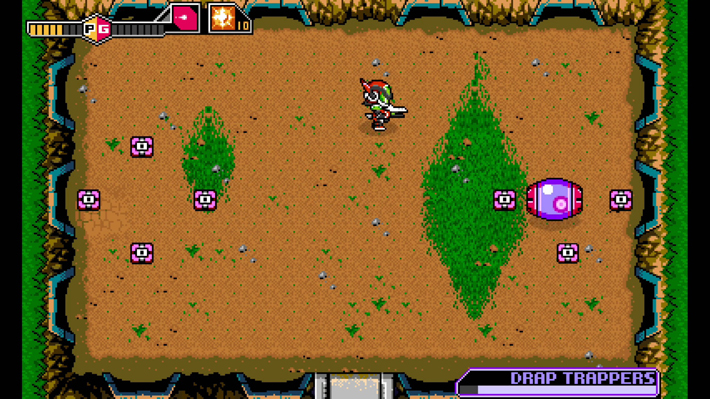
The flow is very similar to the original: players will be able to recover lost live through pickups, indicated by green capsules and upgrade their blaster through red pickups. Small and large pickups exist, worth one and four points like the grey and flashing variants on NES.
But this is where things get interesting; Gun Power not only gives players a series of stronger shot, but also a number of interesting ones such as a reflective barrier, an electric arc or even a flamethrower.
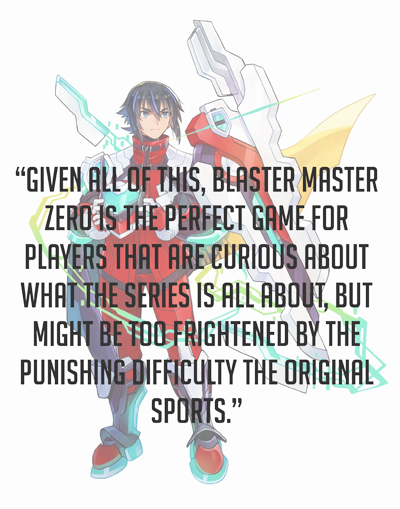 The ultimate attack is, once again, a powerful wave cannon that can traverse terrain and hits a wide swath, but care should still be taken: getting hit will deplete Jason's Gun Power with each impact. However, an ability can be obtained that prevents the loss of gun power if only one hit is sustained. As a bonus, it will even regenerate after a short period of time and that's SUPER-duper helpful, especially in later stages.
The ultimate attack is, once again, a powerful wave cannon that can traverse terrain and hits a wide swath, but care should still be taken: getting hit will deplete Jason's Gun Power with each impact. However, an ability can be obtained that prevents the loss of gun power if only one hit is sustained. As a bonus, it will even regenerate after a short period of time and that's SUPER-duper helpful, especially in later stages.
Players also have a finite amount of grenades, but they can be replenished with new orange crates, once again in small an large varieties. The nifty thing abut grenades is the wide variety that players will have available to them. Your typical chuck-and-duck variety is there, but others like proximity fused, set-then-detonate and even artillery strikes can be obtained throughout the player's time in the main campaign.
In another twist, these sub areas are almost all significant in some way or another, as opposed to the original in which most of the sub areas typically served as a deadly trap designed to sap gun strength and lives in a game with only three continues, period. Here, they almost all feature some kind of new weapon or upgrade to power up Jason of the Sophia or a map to help the player navigate.
Oh, right, that's probably worth mentioning; one of the biggest features we wished was in the original is now fully implemented. Players will fill in rooms as they are reached, but grabbing a map will show players where everything is, tasking them then with only reaching the specified location of any one boss, upgrade or destination. It definitely beats having to memorize an efficient path through the entire game.
Blaster Master Zero is played over the course of 8 areas, just like the original, While thier layouts are very similar, they are more than different enough to provide a vastly different experience compared to Blaster Master NES. Because each sub-area is so important, the playtime is going to be significantly longer as a result, and that's not a bad thing: Blaster Master Zero is a lot of fun to play, and often throws a decent amount of challenge at the player through its myriad bosses and difficult final areas. There are even bosses that players will fight using the Sophia!
Thankfully, the overall difficulty is mitigated by way of a high number of strategically-placed save spots, allowing players to restart quickly if a life is lost in a Sub-Area or to play later if they need a break.
The map is beyond helpful in seeing where players have been and where they need to go and once she's found, players can also talk to Eve for various bits of information anytime.
The controls also work a hell of a lot better than the NES release, especially with regards to wall climbing. With a dedicated button just for crawling over walls and platforms, there is zero risk of getting stuck or falling to your doom when going towards the edge of a platform for a pixel-perfect jump. Friggin' brilliant, literally wouldn't have it any other way.
Given all of this, Blaster Master Zero is the perfect game for players that are curious about what the series is all about, but might be too frightened by the punishing difficulty the original sports. There are even true-last-boss requirements that open up the ninth area, adding another ending and replay for players that may have missed it.
Several game modes like Destroyer mode and a Boss Rush can also be unlocked through various conditions. There's even a multiplayer mode for players to take the game on together. Nifty!
But there's even more. A number of DLC characters, including Gunvolt, Shovel Knight, and even Shantae can be used to play the game, each with thier own unique twists on the formula. They were free at launch for about two weeks each before becoming paid, though the physicals for Blaster Master Zero include them all. They're still worth picking up though.

Picking up where Blaster Master Zero left off, Blaster Master Zero 2 shakes things up even more than the original did. Released on Switch worldwide on March 20, 2019, on Windows the same year, PS4 on June 29, 2020 and Xbox Series consoles forthcoming on July 15, 2021 as of this review, Inti Creates really could have just done more of the same with Zero 2 and we'd have been fine with it.
This... was not the case, and it's great in some respects, but not so much in others.
First the great stuff: The stage design in Blaster Master Zero 2 is friggin' wild. Even in Area 1, players are going to have a lot of fun with the crazy platforming and run-n-gunning it offers. The setup is also neat, with all of the areas players will travel to needing to be discovered first. Maps are doubly important in this respect, as finding charts to discover more and more planetoids is key to upgrading Jason and the new Sophia Gaia will be critical in making the best progress.
Some planetoids are easy breezy. Others have some really tricky puzzles and dexterity challenges. But all are diverse enough to keep the player engaged. The Sophia Battles are also a ton of fun.
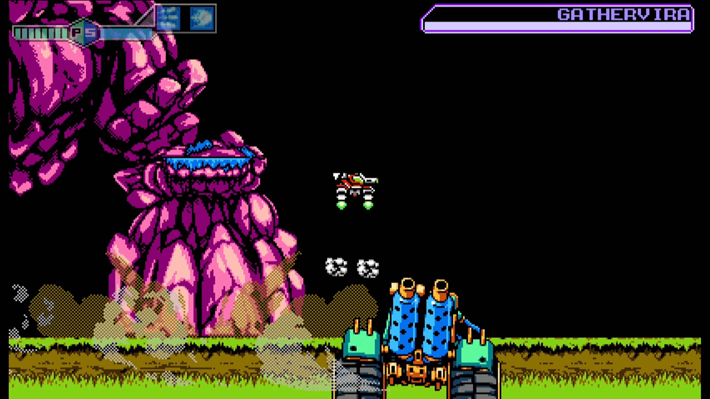
Speaking of the Sophia, This game's model, the Gaia, has a number of different features from the Sophia III in the first game. for starters, this Sophia is almost completely dependent on special energy, meaning once it has been emptied, its power will be greatly diminished. It can still shoot, but it will be incredibly weak while the special energy recharges.
Collecting Blue Capsules helps, but the Gaia has a neat feature. Falling from high places and landing in solid ground will recharge its special energy on impact. ...Videogame logic, just roll with it. This adds a bit more tension to the gameplay which isn't terrible we'd say, but the Sophia III felt better to control as a result.
Like Zero 1 and the original, sub areas are once again a prominent feature, and they play very similarly to the first game. Green capsules for life, red for gun. Players also have a special ability that attacks enemies and bosses for massive damage when their defences are open. These abilities can be very helpful, and are dependent on the energy displayed in a small green gauge, which refills over time.
But this is where things fall apart a bit. Gun upgrades are less about power and more about function and... that's a thing, I suppose, but nothing felt especially powerful out of all of the weapons we've used, even the wave cannon. That's because repeat shots end up weakening the gun until it cools off with no real indicators as to how ready it is to go again.
Enemies are much more aggressive in this one too, not to mention is myriad environmental hazards that are all to ready to chip your newfangled gun to nothing. A power saver like the one in Zero 1 makes a return which helps, is it ever frustrating before you get it.
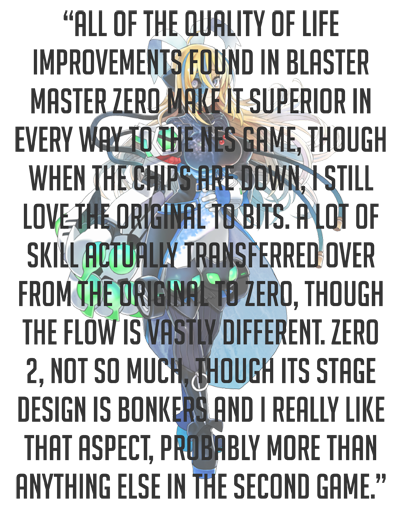 We died way more in this one too, mostly due to some cheap bosses and questionable falls when on foot in the sidecrolling areas. The backtracking required to get around was a bit tiresome as well, with players needing to jump through a bunch of wormholes to go back and forth between various spots that need three or four wormholes to get through. It was a bit much. Maybe a menu next time? We'll see soon enough.
We died way more in this one too, mostly due to some cheap bosses and questionable falls when on foot in the sidecrolling areas. The backtracking required to get around was a bit tiresome as well, with players needing to jump through a bunch of wormholes to go back and forth between various spots that need three or four wormholes to get through. It was a bit much. Maybe a menu next time? We'll see soon enough.
There wasn't anything to unlock this time around after defeating the True Final Boss, probably because the game itself was considerably longer than the first. However, there are three bits of DLC that add a bit more play to Blaster Master Zero 2. Two characters, empress from Dragon Marked for Death and Copen from Luminous Avenger IX add their own twist to the gameplay here and the shooting gallery style Kanna raising Simulator gives players a fresh take on one of the most bizarre areas in the game.
As with the first game, a multiplayer mode is also available.
Overall, while it's still mostly fun, Zero 2 isn't as well balanced as Zero 1, which is a shame, especially since there's a lot to like about its presentation.
On that topic, both games feature some pretty stellar design across the board. High-quality, detailed pixel art is the order of the day, and even the small player sprites on the overworld have enough detail and animation to give them a heft dose of personality. It's even better in the overhead sections; its really hard not to like the visuals here, even if Jason's legs are small and twiddly.
The short of the long of it is, the stages and environments, enemies and vehicles and especially the bosses, all feature excellent design worthy of the Blaster Master name. Even if Jason looks like a dollar-store Zero in the second game.
Of course, Blaster Master is very well-known for its amazing music, and Zero delivers. Especially in the first game, deliciously deep 8-bit tunes permeate the entire game, while staying fresh the whole way through. Some of the sound effects can be a little much; getting used to hearing the Sophia's cannon over and over and over again will take time to get used to.
But Zero 2 was a little worse off. The opening theme is... not great about halfway through. It sounds very placeholer with only two phoned-in parts playing and not near enough harmony. A little dissonance could have added a better texture to the piece. Some of the sound effects are irritating as hell too, like this scattershot.
Menus are easy to navigate with flashy design and great navigation effects while the ingame HUD is easy to read and interperet at a glance, The sub Menu is expanded giving players the ability to select abilities, check maps, and generally see what all has been found and equipped on both Jason and Sophia.
Finally, there's the story. More than just a boy chasing a frog down a radioactive hole, Jason is a luminary in robotics with a keen interest in the planet's recovery after a crippling ice age. Fred is more than just a frog, he's a potentially new species, making his escape more pressing.
Other new faces in the form of Eve who was first seen in the "Worlds of Power" novelization of the original game - and implemented into Blasting Again on Playstation - make their rebooted appearance here and many new characters are encountered throughout Zero 2. There is one character that ended up being pretty annoying, just a complete edgelord in every sense. That was a shame, but not enough to totally kill the plot.
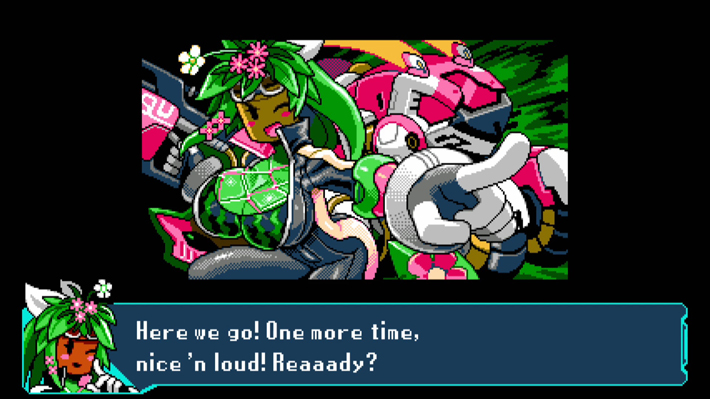
You ever just sit down and marathon a game series? Blaster Master Zero is a great series to do that with so far. Not too short, but not too long, Zero 1 holds the edge though, as Zero 2 faltered in a couple of key areas, especially with regards to weak weapons, environmental hazards and cheap enemies.
More so the first game than the second, the challenge in Blaster Master Zero is very balanced. Players familiar with the original NES game are going to feel right at home, though Zero 2 is still very good. Just not as good.
All of the quality of life improvements found in Blaster Master Zero make it superior in every way to the NES game, though when the chips are down, I still love the original to bits. A lot of skill actually transferred over from the original to Zero, though the flow is vastly different. Zero 2, not so much, though its stage design is bonkers and I really like that aspect, probably more than anything else in the second game.
Each of these titles offers players a relatively lengthy, engaging campaign and all kinds of DLC extras to spice up the gameplay for about 16-18 bucks all-in, depending on the game. Physical editions include all of these DLC bits, adding value.Blaster Master Zero was every bit as good as I'd hoped, and while its sequel didn't quite carry its legacy, there's still potential for a better, more polished conclusion in the next game.
And that brings us to Zero 3; it too will be a direct continuation of 2, and I gotta say, I'm really looking forward to seeing what's going to go down. Be sure to check out and preorder the new physical editions of Blaster Master Zero 3 on Limited Run's site today!
 Blaster Master Zero,
Blaster Master Zero,  Blaster Master Zero 2,
Blaster Master Zero 2,  Limited Run Games | in
Limited Run Games | in  QCF Reviews
QCF Reviews 









